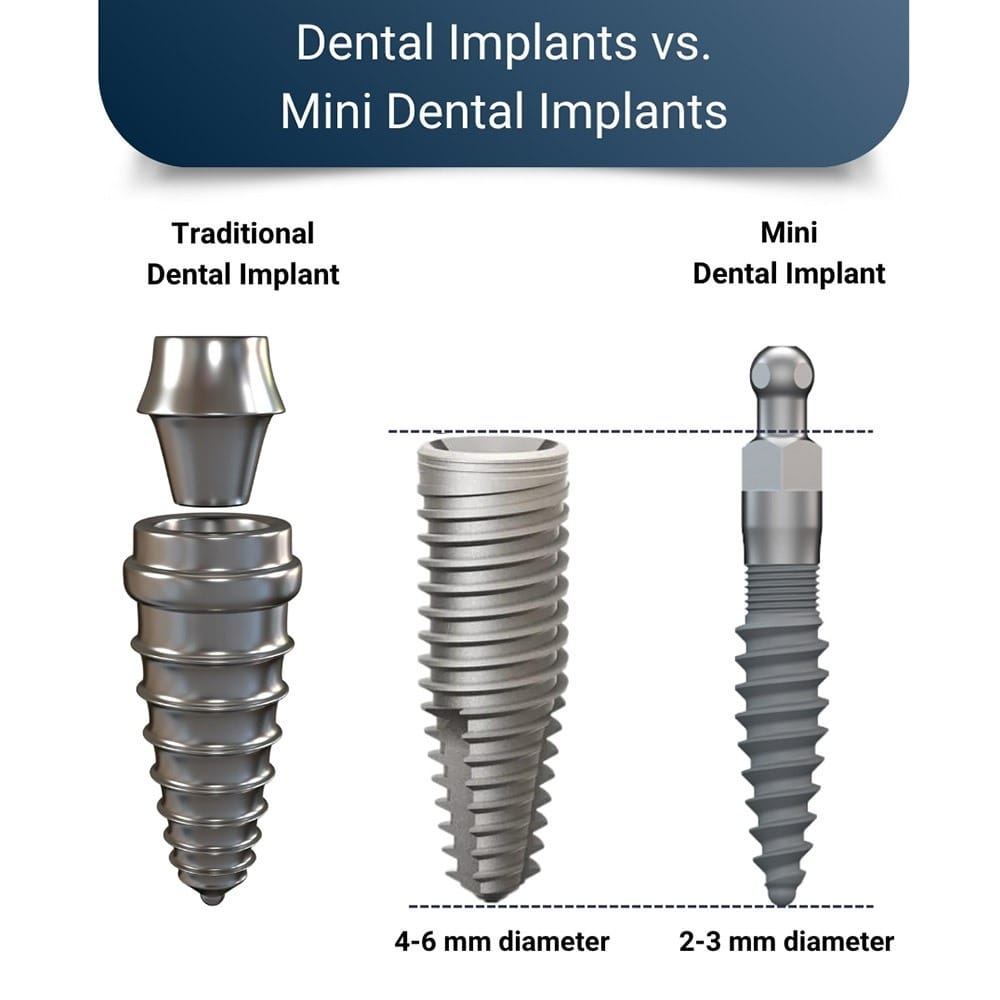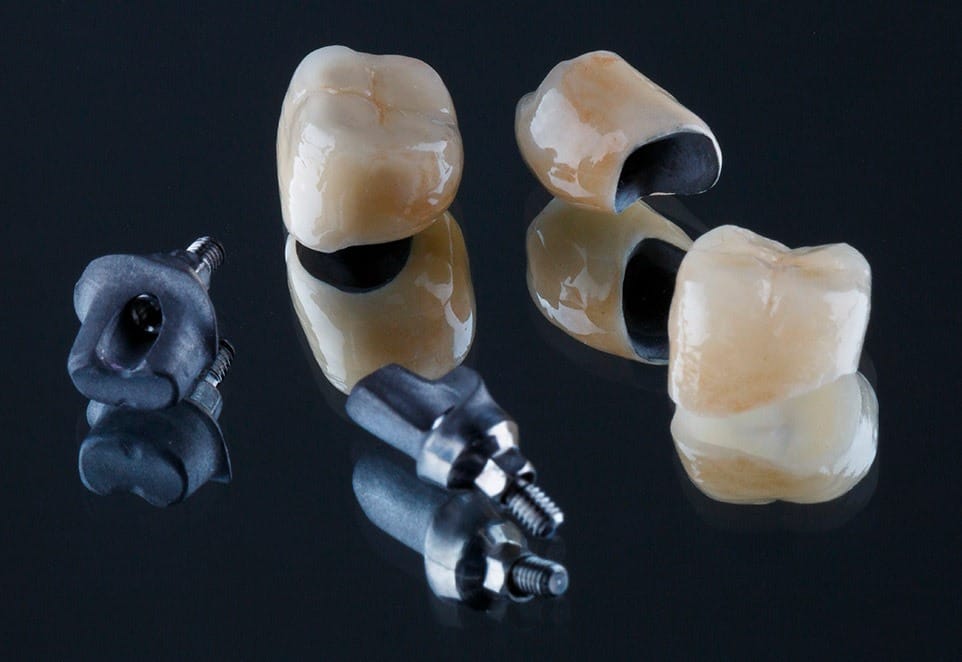When you first see an implant dentist, they can assess your dental health, listen to your concerns and aims for treatment, and help determine the most effective option. Before you go, it can be useful to learn more about ordinary and mini dental implants and their differences. Being better informed will help you ask the right questions when seeing your implant dentist.

Who Is a Candidate for Dental Implants?
Initially, you will need a complete consultation that includes a dental exam, dental x-rays, and a cone beam CT scan to evaluate your suitability for implants. They need to evaluate certain factors, including the following:
Overall Health
Your overall health matters, and while most people can have this treatment, you mustn’t have any uncontrolled conditions like diabetes or autoimmune conditions that could affect healing afterward.
Gum Health
Both mini and traditional dental implants need good gum health. If you have signs of periodontal disease, a bacterial infection that can destroy the gums, you must have this treated first. This is important because periodontal disease can also destroy the jawbone.
Jawbone Health
Dental implants must be surrounded by strong and healthy bone, whether mini or traditional. This is why a cone beam CT scan is necessary to assess your jawbone health. If you lost teeth quite some time ago, your jawbone has likely resorbed and may have lost quite a bit of its original density.
Although mini dental implants require less jawbone than traditional dental implants, they still need a specific amount of bone for successful implantation.
Lifestyle Factors
Any habits like teeth grinding and clenching must be addressed before you can have dental implants. If you smoke, it is best to quit, as smoking slows down healing and increases the risk of implant failure.
Oral Hygiene
You must also be prepared to look after your dental implants. They might be inert, but the tissues around them are living and, unless kept clean, can become infected. Regardless of whether you have mini or traditional implants, the risk of failure increases if you don’t look after them properly.
Dental implants are simple to care for, but you should discuss them with your implant dentist to discover what is required.
What Are Traditional Dental Implants?
A traditional implant is an artificial tooth root consisting of a small post or screw that is inserted directly into your jawbone. It consists of three separate parts.
The first is the implant screw; the second is an abutment that attaches to the implant screw. This protrudes above your gum and supports the third part, the implant restoration. This could be an implant crown, bridge, or denture.
When Are Traditional Implants Used?
Traditional dental implants can restore any tooth in the mouth with sufficient space for the implant to fit. They can support fixed and removable restorations. However, traditional implants require a specific amount of strong and healthy jawbone for successful insertion and Osseointegration, where the implant becomes fused with the surrounding bone.
What Are Mini Dental Implants?
As you may have guessed, mini dental implants are smaller versions of traditional dental implants, hence their name. Usually, traditional-sized dental implants have a diameter between four and 6 mm. In comparison, mini dental implants have a diameter of between two and 3 mm. There is no difference between the length of the implant post.
Mini dental implants are designed slightly differently as most are a one-piece design incorporating the post and abutment in a single unit. The restoration is fitted separately straight onto the dental implant post and abutment.
When Are Mini Implants Used?
Typically, mini dental implants are used to support dentures. They are specially adapted so a denture can clip directly onto the mini implant using a ball and socket design. The denture is still removable so that it can be taken out for cleaning.
Another option is to use mini dental implants where there isn’t enough space for a traditional implant. For example, restoring a small lower incisor or another tooth with limited space.
Mini dental implants can be useful when a patient lacks enough bone density to have traditional dental implants. Although bone grafting can build up missing bone, not everyone wishes to have this procedure or is suitable for the oral surgery required.
There are differences in how traditional and mini dental implants are placed in the jawbone.
With traditional implants, the implant dentist must make a small incision into the gum to expose the bone underneath. They then create a small hole in the bone to insert the dental implant post, tightening it and stitching up the gum so the implants can heal.
Mini dental implants don’t require incisions as the implant post is inserted directly through the gum. Therefore, treatment is less invasive and quicker to complete.
What Are the Benefits of Mini Dental Implants?
To sum up, the benefits of mini dental implants can include the following:
- Treatment is less invasive as the implants are easier to insert. This can be ideal for anyone who fears having oral surgery or who cannot tolerate a longer implant procedure.
- A reduced need for bone grafting can be helpful for anyone who cannot have traditional implants. Suppose you have previously investigated implant treatment and were told you are unsuitable. In that case, you may wish to see if it is possible to revisit this process using mini dental implants instead.
- Mini dental implants provide good functionality and are comfortable and convenient. They provide a greater biting strength compared to traditional dentures.
- Because the oral surgery is less invasive, there is a lower risk of complications afterward.
How to Choose between Mini Dental Implants and Traditional Dental Implants?
Mini dental implants have only been used for around twenty years, a far shorter time than traditional implants. Therefore, there is far less information on the longevity of mini dental implants, but they can be a good solution in specific circumstances.
However, if a mini dental implant fails, the whole implant may need to be removed. In comparison, with a traditional dental implant, it’s possible to replace separate components like the implant abutment so they can last longer.
There is a lot to consider, but a good dental implant dentist at Clock Tower Dental will take the time to talk these options through with you, discuss the pros and cons of each, and help you make the right choice.

